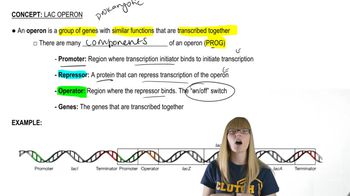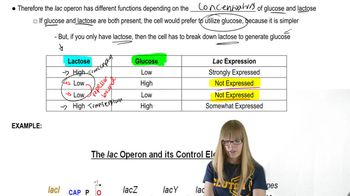Table of contents
- 1. Introduction to Genetics51m
- 2. Mendel's Laws of Inheritance3h 37m
- 3. Extensions to Mendelian Inheritance2h 41m
- 4. Genetic Mapping and Linkage2h 28m
- 5. Genetics of Bacteria and Viruses1h 21m
- 6. Chromosomal Variation1h 48m
- 7. DNA and Chromosome Structure56m
- 8. DNA Replication1h 10m
- 9. Mitosis and Meiosis1h 34m
- 10. Transcription1h 0m
- 11. Translation58m
- 12. Gene Regulation in Prokaryotes1h 19m
- 13. Gene Regulation in Eukaryotes44m
- 14. Genetic Control of Development44m
- 15. Genomes and Genomics1h 50m
- 16. Transposable Elements47m
- 17. Mutation, Repair, and Recombination1h 6m
- 18. Molecular Genetic Tools19m
- 19. Cancer Genetics29m
- 20. Quantitative Genetics1h 26m
- 21. Population Genetics50m
- 22. Evolutionary Genetics29m
12. Gene Regulation in Prokaryotes
Lac Operon
Problem 15
Textbook Question
Textbook QuestionThe creation of milk products such as cheeses and yogurts is dependent on the conversion by various anaerobic bacteria, including several Lactobacillus species, of lactose to glucose and galactose, ultimately producing lactic acid. These conversions are dependent on both permease and β-galactosidase as part of the lac operon. After selection for rapid fermentation for the production of yogurt, one Lactobacillus subspecies lost its ability to regulate lac operon expression [Lapierre, L., et al. (2002). J. Bacteriol. 184:928–935]. Would you consider it likely that in this subspecies the lac operon is on or off? What genetic events would likely contribute to the loss of regulation as described above?
 Verified Solution
Verified SolutionThis video solution was recommended by our tutors as helpful for the problem above
Video duration:
1mPlay a video:
299
views
Was this helpful?
Related Videos
Related Practice



